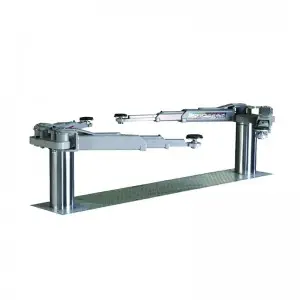[ac series]Understanding the Evolution and Application of AC Series Circuits in Modern Electrical Engineering: A Comprehensive Guide
****
In the realm of electrical engineering, alternating current (AC) circuits play a pivotal role in powering our homes, industries, and technological advancements. Among the various configurations of AC circuits, the AC series circuit stands out for its unique characteristics and applications. This article delves into the fundamentals of AC series circuits, examining their principles, components, advantages, disadvantages, and real-world applications.
What is an AC Series Circuit?
An AC series circuit is a type of electrical circuit in which components are connected end-to-end in a single path, allowing for the flow of alternating current. In such setups, the same current flows through all components, but the voltage may vary across each component due to their individual impedances. The behavior of an AC series circuit is primarily determined by resistance (R), inductance (L), and capacitance (C), creating what is known as an RLC series circuit when all three types of components are present.

Understanding the Evolution and Application of AC Series Circuits in Modern Electrical Engineering: A Comprehensive Guide
Components of AC Series Circuits
1. **Resistor (R)**: This component opposes the flow of current, converting electrical energy into heat through Joule heating. It plays a crucial role in defining the overall resistance in the circuit.
2. **Inductor (L)**: Often made of coils of wire, inductors store energy in a magnetic field when current flows through them. They oppose changes in current and contribute to the circuit’s reactance.
3. **Capacitor (C)**: Capacitors store energy in an electric field and release it when needed. They oppose changes in voltage and can significantly influence the phase relationship between current and voltage in AC circuits.
4. **AC Voltage Source**: This can be a generator or a plug connected to the electrical grid, providing the alternating voltage needed to energize the circuit.
AC Series Circuit Behavior
In an AC series circuit, the total impedance (Z) is determined by combining resistance (R), inductive reactance (XL), and capacitive reactance (XC) using the following equation:
\[ Z = \sqrt{R^2 + (X_L – X_C)^2} \]
Where:
– \( X_L = 2\pi f L \) (inductive reactance)
– \( X_C = \frac{1}{2\pi f C} \) (capacitive reactance)
Here, \( f \) represents the frequency of the alternating current. The impedance affects the total current flowing through the circuit. This relationship also leads to a phase difference between the current and voltage, commonly expressed through the phase angle \( \phi \):
\[ \tan(\phi) = \frac{X_L – X_C}{R} \]
Advantages and Disadvantages of AC Series Circuits
**Advantages**:
1. **Simplicity**: With a single path for current flow, designing and analyzing AC series circuits can be less complex compared to parallel circuits.
2. **Predictable Current**: Since the same current flows through all components, calculating total circuit behavior becomes straightforward.
3. **Lower Components Count**: In certain applications, fewer components are required, simplifying construction and reducing costs.
**Disadvantages**:
1. **Voltage Drops**: In an AC series circuit, voltage drops across individual components can lead to inefficiencies, particularly if the total resistance is high.
2. **Overall Circuit Failure**: If one component fails, it interrupts the current flow throughout the entire circuit, causing all connected devices to cease operation.
3. **Power Factor Issues**: The reactive components (inductors and capacitors) can lead to phase differences, potentially resulting in poor power factor and decreased efficiency.
Applications of AC Series Circuits
AC series circuits are commonly employed in numerous applications, notably in:
1. **Lighting Circuits**: Series arrangements of light bulbs can be used in decorative lighting, where the aesthetic appearance of a single string of lights is desired.

Understanding the Evolution and Application of AC Series Circuits in Modern Electrical Engineering: A Comprehensive Guide
2. **Transformer Windings**: The windings of transformers can often be modeled as a series circuit, facilitating enhanced energy transfer.
3. **Test Equipment**: Many AC measuring instruments, like oscilloscopes and signal generators, require series circuits for calibrating signals.
4. **Small Appliances**: Certain household appliances, such as radios and televisions, utilize AC series circuits for their operational needs.

Understanding the Evolution and Application of AC Series Circuits in Modern Electrical Engineering: A Comprehensive Guide
Conclusion
AC series circuits, with their unique properties and applications, form an essential aspect of electrical engineering. Understanding their fundamental principles is crucial for anyone looking to delve deeper into the world of electricity. Whether it’s for academic pursuits, practical applications, or simply enhancing one’s knowledge, the study of AC series circuits remains a significant area of focus. As technology evolves, the principles surrounding AC series circuits will continue to adapt, proving their lasting relevance in modern society.New Engery Vehicle Battery Lift
